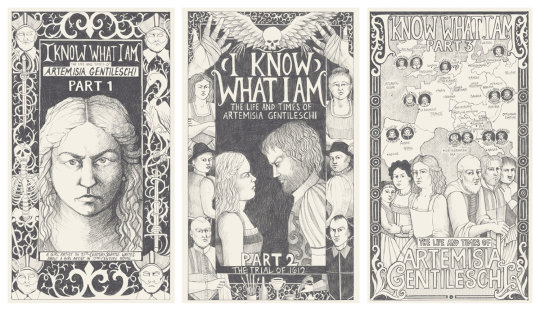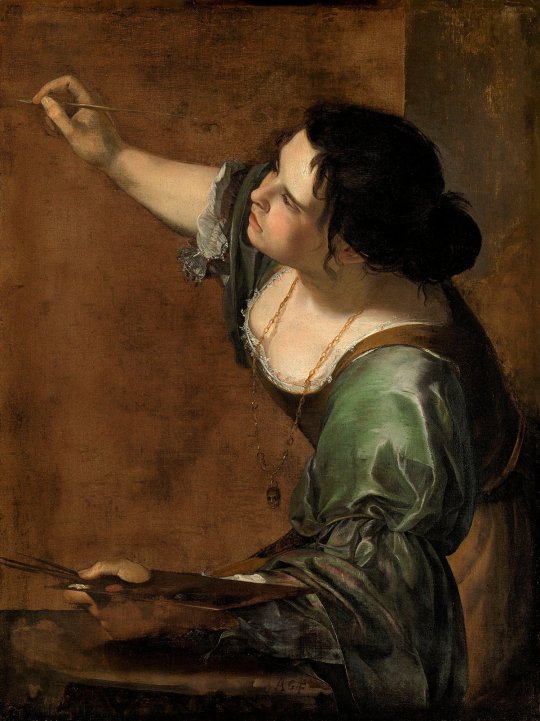Don't wanna be here? Send us removal request.
Text

Object name: Collection of drawings by Gina Siciliano Date: 2019 Location: artist's personal collection
Interpretive panel:
Interest in Artemisia Gentileschi has grown in recent years as historians have been able to learn more about her life, as has the interest in historically underappreciated female artists and feminist art. Gina Sicilliano's graphic novel "I Know What I Am: The Life and Times of Artemisia Gentileschi" was inspired by an art history course and Siciliano being able to see Judith Slaying Holofernes in person at the Uffizi Gallery. The biography covers Gentileschi's whole life, from growing up working for her father to being left by her husband and raising her last remaining daughter to be a painter like her.
When speaking on the growing research regarding Gentileschi, Siciliano said, "We’ll never know the ‘real’ Artemisia, all we can do is continue the discussion."
0 notes
Text

Object name: Self-Portrait as the Allegory of Painting (La Pittura) by Artemisia Gentileschi Date: c. 1638 Location: Windsor Castle
Interpretive panel: In this painting, Gentileschi depicts herself as the female personification of painting. Inspired by the Iconologia of Cesare Ripa, this particular portrait was unique in that it was something that Gentileschi's male peers could not paint. It contains a number of details which are similar to Ripa's original allegory of painting, but removes the mask that Ripa's version wore which read, "imitation," meant to mock the art of painting.
0 notes
Text

Object name: The Right Hand of Artemisia Gentileschi Holding a Brush by Pierre Dumonstier II Date: 1625 Location: The British Museum
Interpretive panel:
On the back of this drawing, Pierre Dumonstier II wrote, "The hands of Aurora are praised and renowned for their rare beauty. But this one is a thousand times more worthy for knowing how to make marvels that send the most judicious eyes into raptures." It was believed to have been drawn in 1625 when Gentileschi had returned to Rome after living in Florence for seven years, at the same time Dumonstier was visiting the city. It serves as a testament to her growing fame how well regarded her art was.
1 note
·
View note
Text

Object name: Judith Slaying Holofernes by Artemisia Gentileschi Date: c. 1620 Location: Uffizi Gallery
Interpretive Label:
One of her more iconic paintings, Gentileschi depicts Judith of Bethulia who saved her city and Jerusalem from siege by charming and then beheading the general of the besieging Assyrian army. The painting is unique in its comparison to the painting of the same scene by Caravaggio; in the latter, Judith stays almost fully at arm’s length away from her victim, still appearing pretty if not somewhat confused at what she is doing while her maid stands at her side and watches. Here, we see Gentileschi depict the same scene with far more realism as Judith must lean over Holofernes while her maid assists in holding the general down as some of the blood spray splatters on Judith’s chest.
0 notes
Text

Object name: Letter from Artemisia Gentileschi to Francesco Maria Maringhi Date: c. 1618 Location: Archivio Storico Frescobaldi
Interpretive Label:
This letter was addressed to Gentileschi's lover, Francesco Maria Maringhi. Her writing contains a number of errors and many words are spelled phonetically, which is unsurprising given that at her rape trial, she had claimed to not know how to write and only knew very little of how to read.
She opens up to Maringhi about her concerns about her weight gain, envying that he is in Florence while she is in Rome, and later the death of her young son, Cristofano.
0 notes
Text
[No photo available]
Object name: Roman Court Rapes and Procurements: The Curia and the State versus Agostino Tassi Painter Date: 1612 Location: Archivio di Stato di Roma
Interpretive label:
In this piece, we can see Artemisia’s own words describing what happened to her. Even when subject to an archaic form of “lie-detector,” torture with thumbscrews, she did not relent and remained adamant in her account. Agostino Tassi, previously one of her father's associates who had at first promised to marry her, would be found guilty of dishonoring the Gentileschi family for reneging on his promise. Accounts differ on what his punishment was; some sources say that he was sentenced to two years in jail, for which he only served eight months. Others say he was officially banished from Rome, a punishment which was almost never enforced, and Tassi's case was no different.
0 notes
Text
Introduction Panel
Artemisia Gentileschi was a Baroque artist born in Rome in 1593, and the eldest daughter of painter Orazio Gentileschi. Although Orazio is believed to have introduced all of his children to the art of painting and had them work in his workshop, Artemisia displayed exceptional talent, much like her father in her influence by the works of Caravaggio. After being raped at the age of 17 by one of her father’s associates, Orazio arranged a marriage for Artemisia to another artist from Florence, where she moved and was able to establish herself as a court painter and did work for the Medici family.
While she was rather successful in her own time, Artemisia has been woefully under-recognized by academics since. Many of her paintings have at one time or another been falsely attributed to either her father or Caravaggio, in part due to her dynamic style of painting. Artemisia’s oeuvre depicts women not as fragile nor delicate, but as strong and intentional, capable of committing political murder and handling the gore that comes with it. Such a style was controversial in its own time, and certainly would not have been attributed to a woman. In the modern day, we can hopefully more fully appreciate Artemisia Gentileschi as also being a strong, intentional woman with a bold style.
0 notes